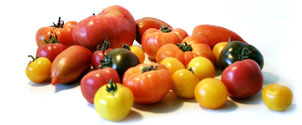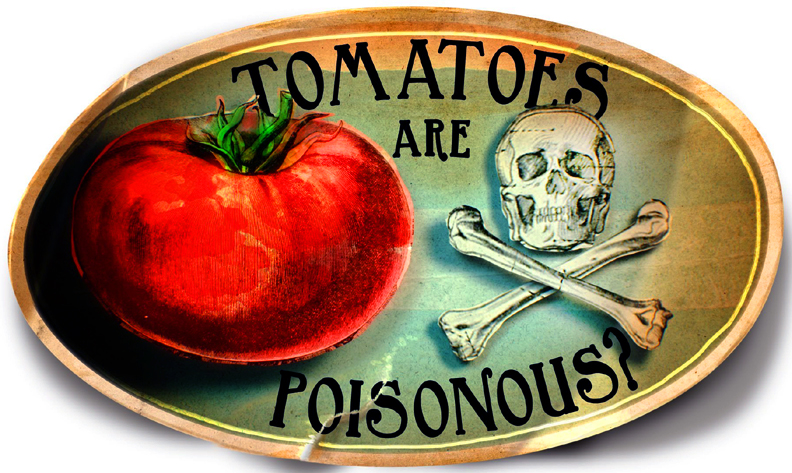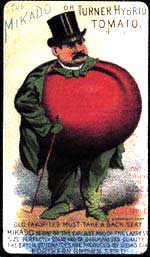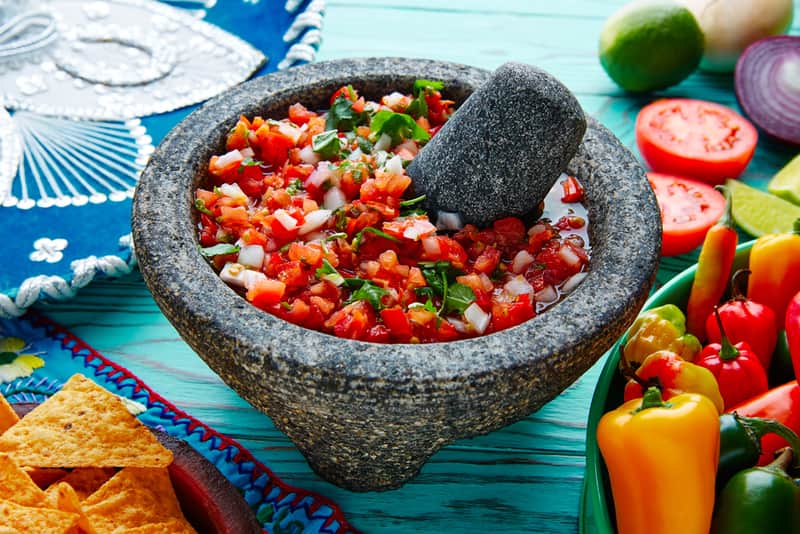To eat or not to eat … the tomato! A fruit once shrouded in suspicion, it wins the love of Europe
By Michelle Bakeman
The following is my English translation of a poem by my favorite Chilean poet, Pablo Neruda, which expresses his adoration and mine for the tomato, somethi ng foodies everywhere will appreciate.
ng foodies everywhere will appreciate.
Ode to the Tomato
The street
was overrun with tomatoes: midday, summer, the light breaks in two tomato halves, and the juice flows in the streets.

Michelle Bakeman
In December the tomato breaks free, invades kitchens, shows up in lunches, sits resting on sideboards, among the glasses, the butter dishes, the blue salt shakers.
It has its own light, a gentle majesty.
We must, unfortunately, murder it: the knife sinks into its living pulp, it is a red viscera, a fresh, deep, inexhaustible sun swells the salads of Chile, happily marries the fair onion, and to celebrate it one allows oil, essential offspring of the olive tree, to fall over its split hemispheres, pepper adds its fragrance, salt its magnetism: they are the weddings of the day, the parsley raises its pennants, the potatoes boil vigorously, the roast beats down the door with its aroma:
it’s time!
let’s go!
and upon the table, in the fold of summer, the tomato, star of the earth, multiplied and fertile star, shows us its convolutions, its canals, the distinguished plenitude and the abundance, no pit, no husk, no scales or thorns, it surrenders to us the gift of its ardent color and the totality of its freshness.
The tomato (Solanum lycopersicum) is a berry, ranging in color from yellows, oranges, to reds, even greens, and purples. It is born as spheres, pears, and ovals in a wide array of sizes, and it evolved from the nightshade (Solanaceae) family of plants. It is replete with the vitamins C and A, contains potassium, folate, vitamin K, and antioxidants that boost the immune system. In addition, the tomato contains lycopene, which is associated with improving the health of the skin, the bones, the prostate, and also aids in lowering blood pressure.
The tomato originated and grew wild in the lower Andes Mountains of South America, most likely in what is now Ecuador and Peru, and slowly made its way north towards pre-Colombian Mesoamerica.
 The first tomato was the approximate size of a pea, and in this humble form, the ancestor to the thousands of tomato varieties we now enjoy. This tomato plant, Solanum pimpinellifolium, is now often referred to as a “pimp,” and it was, in the beginning, nothing more than a weed that appeared in bean and corn fields.
The first tomato was the approximate size of a pea, and in this humble form, the ancestor to the thousands of tomato varieties we now enjoy. This tomato plant, Solanum pimpinellifolium, is now often referred to as a “pimp,” and it was, in the beginning, nothing more than a weed that appeared in bean and corn fields.
In Mesoamerica, it was domesticated and given the name that closely resembles its name in modern languages. In Nahuatl, the language spoken by the Aztecs, the plant was first called “xitomatl,” then “tomatl,” which means “the swelling fruit.” The local population made use of the tomatl as a foodstuff, mixing it with chili peppers and ground up squash seeds to create a sort of sauce. [One may presume that this was the precursor of today’s modern Mexican salsas that are devoured world-wide on a daily basis.] The Aztecs spread rumors that the tomatl held aphrodisiac powers and even increased fertility, and as such, it was given as gifts to newlywed couples. People were also fond of whispering in the shadows that the tomatl was used as a hallucinogenic; an act that would later aid to the widespread misconception that it was poisonous.
 Perhaps the first Europeans to encounter the crops of the New World were aware of the tomatl’s existence, but it was the conquistador, Hernán Cortés, who collected the seeds of this fruit and took them back to Spain, after observing the cultivation of the plant in the Aztec capital, Tenochtitlán. He assumed, quite rightly, that it would naturally thrive in the warm climate of the Mediterranean. And so the Spaniards began to cultivate the tomato as early as the 1540s, buts its popularity as a food was slow to spread to other European nations.
Perhaps the first Europeans to encounter the crops of the New World were aware of the tomatl’s existence, but it was the conquistador, Hernán Cortés, who collected the seeds of this fruit and took them back to Spain, after observing the cultivation of the plant in the Aztec capital, Tenochtitlán. He assumed, quite rightly, that it would naturally thrive in the warm climate of the Mediterranean. And so the Spaniards began to cultivate the tomato as early as the 1540s, buts its popularity as a food was slow to spread to other European nations.
For many years, the tomato was misidentified and regarded as dangerous. In German folklore, plants from the same nightshade family were used by witches to summon werewolves. The old German word for tomato, “wolfpfirsich,” translates as “wolf peach,” stemming from the fruit’s first scientific name, “Lycopersicon,” meaning the same in Old Latin. Eventually, Lycopersicon was changed to lycopersicum, and there it stayed. To compound suspicion, the morphology of the plant has a close relationship to the poisonous members of the Solanaceae family, such as deadly nightshade (belladonna) and mandrake.

An illustration from De Materia Medica by the Greek physician Dioscorides, made in 1460. Credit: BBCNews.com
As deadly nightshade had been used as a hallucinogenic, rumors emerged about the safety of tomato consumption. Known as belladonna, and translating as “beautiful woman,” the plant was given this name as women in medieval times used its extract to dilate the pupils of their eyes in an effort to seem more seductive. This plant does indeed possess hallucinogenic properties that grant its user the sensation of flying as well as visions, and therefore, the presumption was that it was used in witchcraft.
Guilty by association, the tomato’s reputation became tainted. For more than 150 years after its introduction, the tomato was used in Italy only as a tabletop decoration. It was revered for its beauty and was bred to create a plethora of shapes and colors. The Italians referred to it as “pomodoro,” meaning “golden apple,” and some allege that the French called it “pomme d’amour,” or “love apple” due to the rumors of its aphrodisiac potency. But even with all of these flowery names, the fruit could not lure most Europeans to eat it, and it continued to be seen as unsavory.

In England, the tomato’s fate was similar, and although the English were aware of the plant by the 1600s, they dared not consume it. Their fear was carried to North America by the first colonists and was perpetuated until well into the eighteenth century. It only began to be dispelled after the Spanish and the Italians had fully embraced it as a food and were seen consuming it over the course of many years. Thomas Jefferson began planting the crop as early as 1781, but it was not widely cultivated for at least four more decades, as so many people persisted in their belief that the tomato was deadly.
There is the story of a Colonel Robert Gibbon Johnson, who on September 26, 1820, took it upon himself to end the misconception. It is said that at noon on that day, on the steps of a New England courthouse, he consumed not one, but an entire basket of tomatoes in front of the whole town, who had gathered together to bear witness to his death afterward, which of course did not come.

Eating tomatoes on the courthouse steps
Today, the tomato is perhaps the world’s most popular fruit, produced globally more than any other fruit, overshadowing the beloved banana, the sweet mango, and even the glorious apple. Its popularity in the United States is owed in large part to the influx of Spanish and French immigrants in the early 1800s to Louisiana and Florida, lending to the birth of Creole cuisine, which so often celebrates the tomato. That, in addition to the contributions of the cuisine of Italian immigrants flooding the nation throughout the 1800s, solidified the tomato’s importance in the burgeoning cuisines of the country.
On the global stage, the tomato emerged front and center as a star. Imagine for a moment Mexican food without salsa, Spanish food without gazpacho, or the flavors of Italy without pizza and marinara sauce. Eventually, the French embraced the fruit with a whole heart, employing it as the base of one of the five Mother sauces of traditional French cooking, in effect, making it a part of the foundation of one of the most revered cuisines in the world. The French stuff and bake tomatoes, use them as an essential component of ratatouille, and create beautiful savory tomato tarts to wow the senses.
And while the tomato was transforming French, Italian, and Spanish palates, it was working, as well, to change the activity in Portuguese kitchens forever. The Portuguese began to add the tomato to those dishes from which they sought a particular tanginess and spice. Known for their skills as fishermen, they pull from the sea cod, shrimp, clams, mussels, and a host of other creatures and combine them with the tomato to produce dishes such as Arroz Malandro, where rice is prepared with a mix of seafood, tomatoes, bell peppers, onions, and white wine. They also boast such dishes as cod or chicken in tomato sauces topped with sliced olives and parsley, sometimes with rice, sometimes baked with sliced potatoes. And finally there is the classic staple Portuguese dish, the Francesinha, consisting of two slices of bread filled with meats such as ham, sausage, and steak, smothered with melted cheese and then a spicy tomato sauce, often crowned by a fried egg, the ultimate in Portuguese comfort food.

Pico de Gallo credit: allfoodsrecipes.com
And so the tomato carved for itself a place of honor at the tables of the countries of Western Europe that hug the Mediterranean Sea. From there, it was only a matter of time before it traveled to the kitchens of the East, to forever revolutionize the way the peoples of the world eat, the artistry of their dishes, and the preferences of their palates, as it wasn’t long before they began to crave the feel and the taste of its rich, sun-kissed, crimson acidity upon their tongues.
Sources
Britannica.com. Tomato
Scribol.com. The secret history of the tomato. VegetableFacts.net. History of tomatoes
Michelle Bakeman has a bachelor’s degree from the University of Virginia in Spanish and Latin American Studies. She is also a graduate of the Culinary Arts Institute of Louisiana. She has been a chef for twenty-two years, has owned and operated several restaurants, and has been a teacher for sixteen years. She moved to Cuenca in 2013.





















